More SARA & EVL UDPmon Large Results and SNMP
Description
UDP Experiments were performed with a modified version of the
UDPmon package written by
R.E. Hughes-Jones in the sense that from 5000 packets the sequence
number and the arrival time in microsec. are specified. There was no wait time
between two successive packets. Before and after these tests also the
appropriate SNMP counters at the interfaces were read to check if packets lost
did occur at these interfaces during the measurement. The tests were focused to
the hosts located at SARA and
EVL in various topologies.
However, more general UDPmon
Large results are available in this document.
Loop-Back Test Results
Setup
In these tests hosts gwgsara4 and gwgsara5 were directly
connected with the Cisco ONS and at the Chicago site a hardware loop has
been used, according to the scheme listed below.
Interfaces from which sensible counter values can be read out have been marked
with "S".
UDPmon Large
The tests were performed with packet sizes of 500, 1000, 1200, and
1460 bytes. The time differences with the first packet as function of the
packet sequence number are displayed in the
.
In
the bandwidth calculated from the sequence number from the last received
packet without lost (Last_Recv_Seq_Nr), the packet size in bytes
calculated
with ,
the Last_Recv_Seq_Nr field, and the # packets lost have been
specified as function of the packet size.
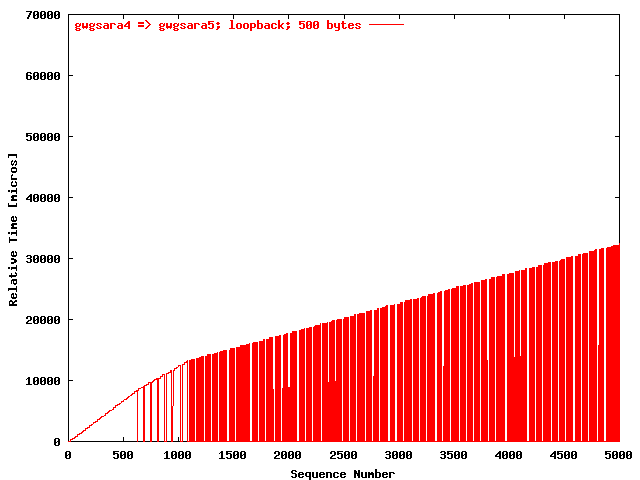
| .I. |
|
The relative receiving time as funtion of the packet
sequence number for the UDP stream gwgsara4 =>
gwgsara5 using the loop-back interface. The packet size
was 500 bytes. |
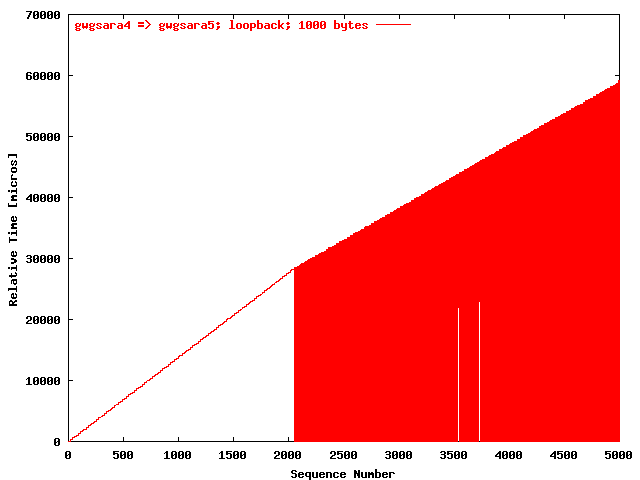
| .II. |
|
The relative receiving time as funtion of the packet
sequence number for the UDP stream gwgsara4 =>
gwgsara5 using the loop-back interface. The packet size
was 1000 bytes. |
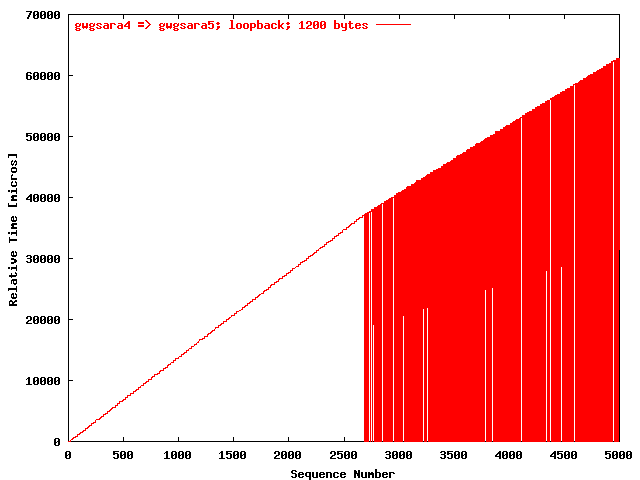
| .III. |
|
The relative receiving time as funtion of the packet
sequence number for the UDP stream gwgsara4 =>
gwgsara5 using the loop-back interface. The packet size
was 1200 bytes. |
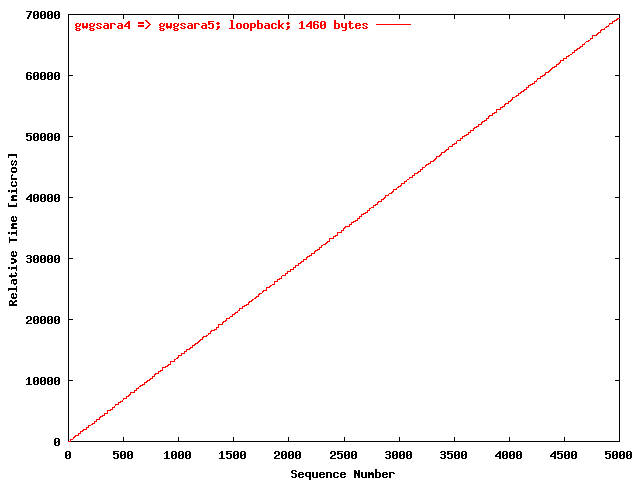
| .IV. |
|
The relative receiving time as funtion of the packet
sequence number for the UDP stream gwgsara4 =>
gwgsara5 using the loop-back interface. The packet size
was 1460 bytes. |
Packet size
[bytes]
|
Bandwidth
[Mbit/S]
|
Last recv.
eq. nr
|
# Packets
lost
|
| 500 |
300 |
626 |
2599 |
| 1000 |
577 |
2053 |
720 |
| 1200 |
692 |
2689 |
438 |
| 1460 |
841 |
4999 |
0 |
| . |
|
The bandwidth calculated
with ,
the last received packet without lost, and the
# packets lost given as function of the packet
size. The loop-back interface has been
used. |
SNMP Counters
By using the appropriate incoming and outgoing octet counters, marked with
"S" in the scheme, packet lost at the
following route trajectories can be detected:
- From Amsterdam to Chicago over the Lambda
- Over the loop-back interface.
- From Chicago to Amsterdam over the Lambda.
When the appropriate incoming and outgoing octet counters for these route parts
were compared before and after the UDPmon test, no packet lost have been found.
Note that only the Gigabit interfaces are capable of delivering octet counters.
Conclusions
Because no packets were dropped according to the SNMP counters, all packets lost
where probably host effects.
LSD 6509 Test Results
Setup
In these tests the LSD 6509 have been used in the place of the hardware
loop, described in the previous section.
The following scheme have been used, where again
"S" is marking an interface from which the octet counters
can be read with SNMP. At the LSD 6509 we had no authorisation to read SNMP
counters.
The path followed in this test was:
gwgsara2 =>
Amsterdam ONS =>
Chicago ONS =>
6509 =>
Chicago ONS =>
Amsterdam ONS =>
gwgsara4.
UDPmon Large
The tests were performed with packet sizes of 500, 1000, 1200 and
1460 bytes. The relative time differences as function of the packet
sequence number are displayed in the
In
the bandwidth and packets lost data have been given as function of the packet
size.
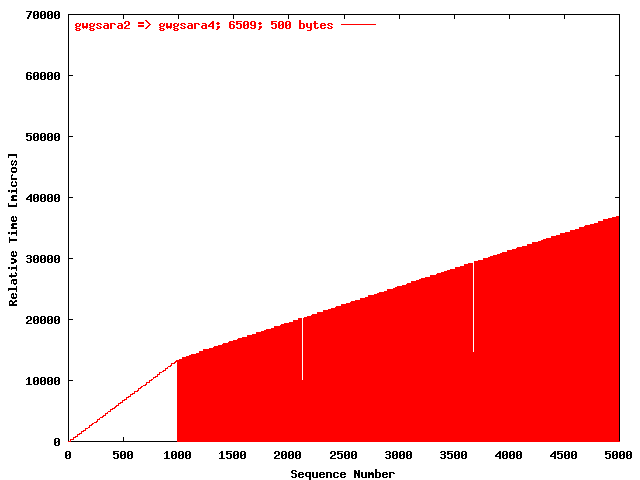
| .I. |
|
The relative receiving time as funtion of the packet
sequence number for the UDP stream gwgsara2 =>
gwgsara4 using the 6509. The packet size was
500 bytes. |
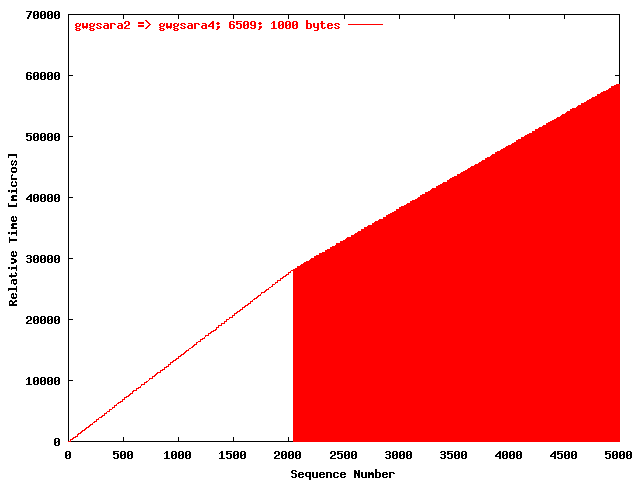
| .II. |
|
The relative receiving time as funtion of the packet
sequence number for the UDP stream gwgsara2 =>
gwgsara4 using the 6509. The packet size was
1000 bytes. |
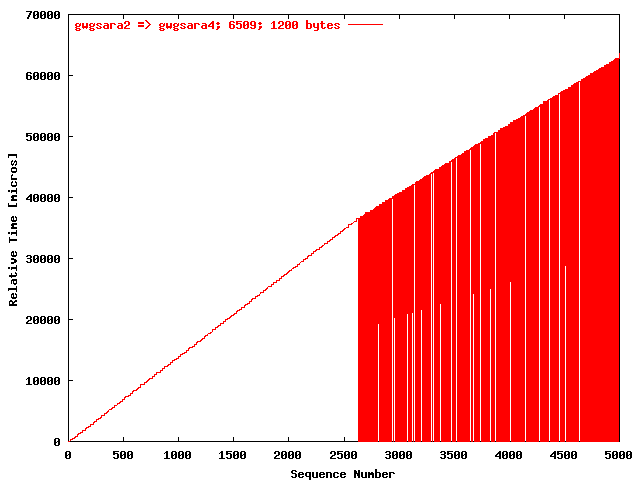
| .III. |
|
The relative receiving time as funtion of the packet
sequence number for the UDP stream gwgsara2 =>
gwgsara4 using the 6509. The packet size was
1200 bytes. |
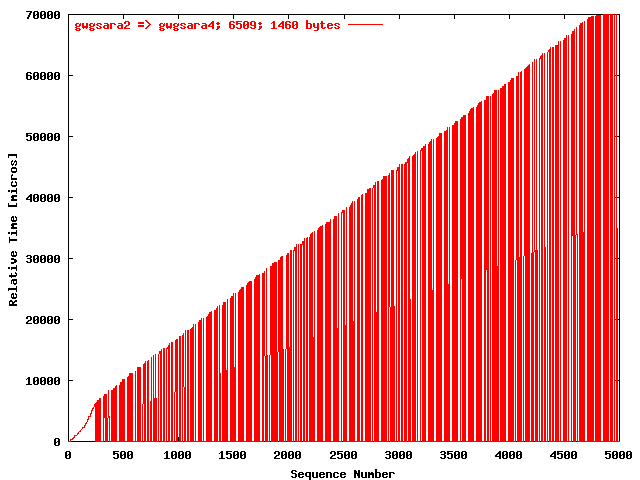
| .IV. |
|
The relative receiving time as funtion of the packet
sequence number for the UDP stream gwgsara2 =>
gwgsara4 using the 6509. The packet size was
1460 bytes. |
Packet size
[bytes]
|
Bandwidth
[Mbit/S]
|
Last recv.
eq. nr
|
# Packets
lost
|
| 500 |
298 |
990 |
2254 |
| 1000 |
578 |
2040 |
729 |
| 1200 |
691 |
2630 |
444 |
| 1460 |
462 |
241 |
3069 |
| . |
|
The bandwidth calculated
with ,
the last received packet without lost, and the
# packets lost given as function of the packet
size. The 6509 has been used. |
SNMP Counters
By using the appropriate incoming and outgoing octet counters, marked with
"S" in the scheme, packet lost at the
following route trajectories can be detected:
- From Amsterdam to Chicago over the Lambda
- Over the LSD 6509.
- From Chicago to Amsterdam over the Lambda.
When the appropriate incoming and outgoing octet counters for these route parts
were compared before and after the UDPmon test, no packet lost have been found.
Note that only the Gigabit interfaces are capable of delivering octet counters
and we were not authorised to read the LSD 6509 counters.
Conclusions
Because no packets were dropped according to the SNMP counters, all packets lost
where probably host effects.
SSR + LSD 6509 Test Results
Setup
For these tests host gwgsara2 is connected to the Cisco ONS via the
SSR 8000. Also at the EVL host prusin has been connected to the
Chicago ONS. The setup from section
"LSD 6509 Test Results" has been
developed to the following scheme, were again the
octet counter capable interfaces have been marked
with "S".
In this setup the following paths have been tested:
-
gwgsara2 =>
SSR =>
Amsterdam ONS =>
Chicago ONS =>
6509 =>
Chicago ONS =>
Amsterdam ONS =>
gwgsara4
-
gwgsara2 =>
SSR =>
Amsterdam ONS =>
Chicago ONS =>
6509 =>
prusin
-
gwgsara4 =>
Amsterdam ONS =>
Chicago ONS =>
6509 =>
Chicago ONS =>
Amsterdam ONS =>
SSR =>
gwgsara2
-
prusin =>
6509 =>
Chicago ONS =>
Amsterdam ONS =>
SSR =>
gwgsara2
UDPmon Large
Also here the tests were performed with packet sizes of 500, 1000, 1200 and
1460 bytes. Below the relative time differences are presented for the
paths mentioned in the
"Setup" subsection as follows:
-
Path gwgsara2 => gwgsara4 in
.
-
Path gwgsara2 => prusin in
.
-
Path gwgsara4 => gwgsara2 in
.
-
Path prusin => gwgsara2 in
.
In
the bandwidth and packets lost data have been given as function of the packet
size for all paths.

| .I. |
|
The relative receiving time as funtion of the packet
sequence number for the UDP stream gwgsara2 =>
gwgsara4 using the SSR + 6509. The packet size was
500 bytes. |

| .II. |
|
The relative receiving time as funtion of the packet
sequence number for the UDP stream gwgsara2 =>
gwgsara4 using the SSR + 6509. The packet size was
1000 bytes. |

| .III. |
|
The relative receiving time as funtion of the packet
sequence number for the UDP stream gwgsara2 =>
gwgsara4 using the SSR + 6509. The packet size was
1200 bytes. |

| .IV. |
|
The relative receiving time as funtion of the packet
sequence number for the UDP stream gwgsara2 =>
gwgsara4 using the SSR + 6509. The packet size was
1460 bytes. |
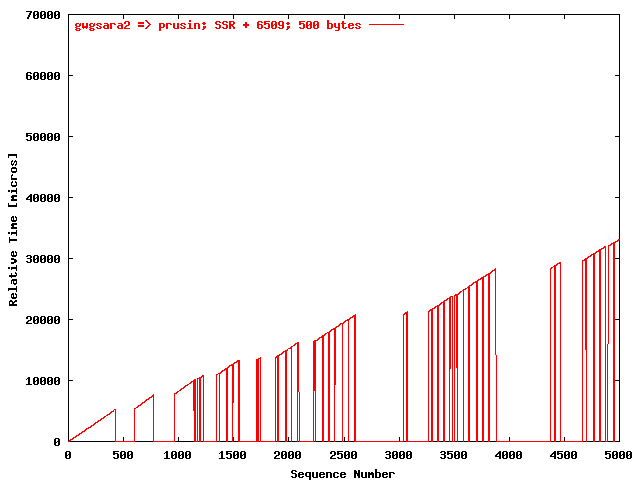
| .I. |
|
The relative receiving time as funtion of the packet
sequence number for the UDP stream gwgsara2 =>
prusin using the SSR + 6509. The packet size was
500 bytes. |
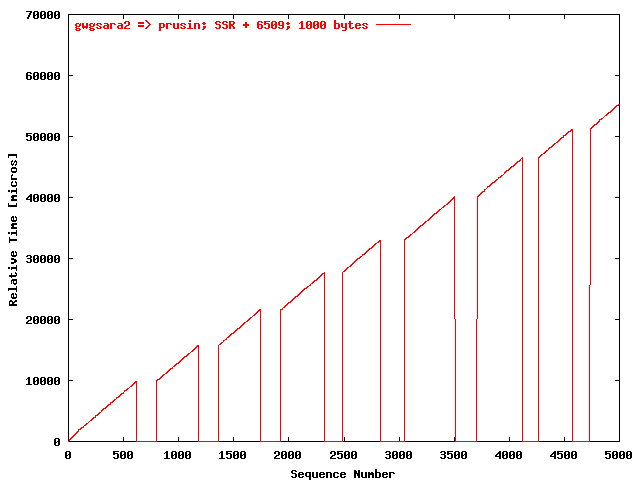
| .II. |
|
The relative receiving time as funtion of the packet
sequence number for the UDP stream gwgsara2 =>
prusin using the SSR + 6509. The packet size was
1000 bytes. |
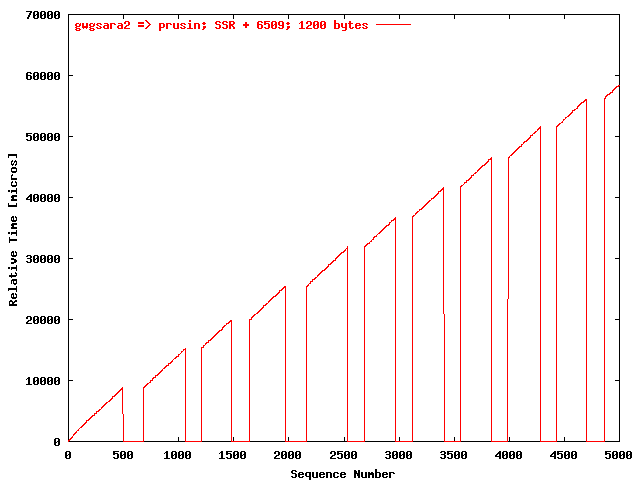
| .III. |
|
The relative receiving time as funtion of the packet
sequence number for the UDP stream gwgsara2 =>
prusin using the SSR + 6509. The packet size was
1200 bytes. |
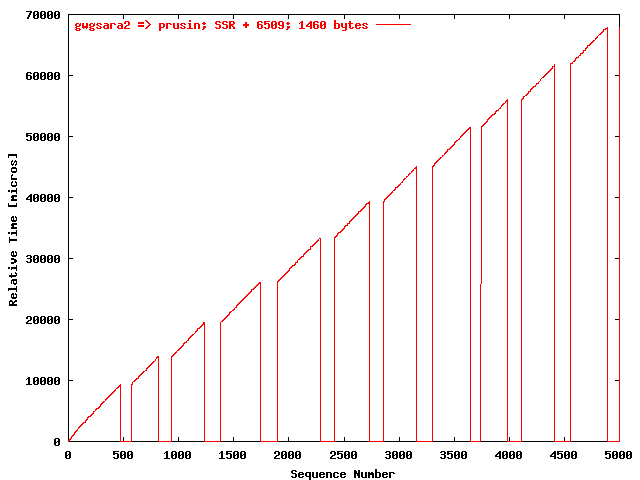
| .IV. |
|
The relative receiving time as funtion of the packet
sequence number for the UDP stream gwgsara2 =>
prusin using the SSR + 6509. The packet size was
1460 bytes. |
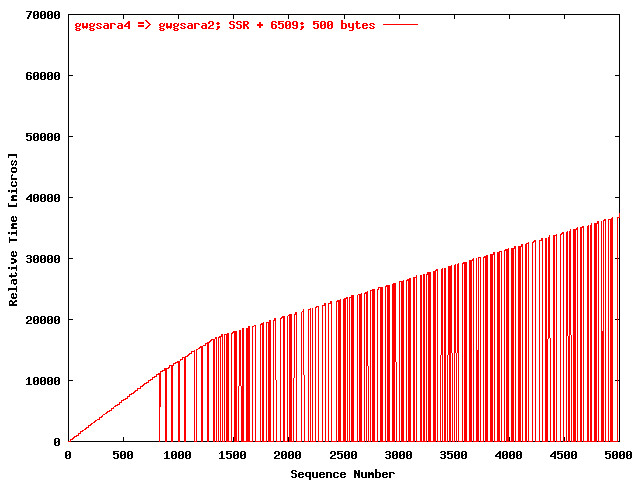
| .I. |
|
The relative receiving time as funtion of the packet
sequence number for the UDP stream gwgsara4 =>
gwgsara2 using the SSR + 6509. The packet size was
500 bytes. |
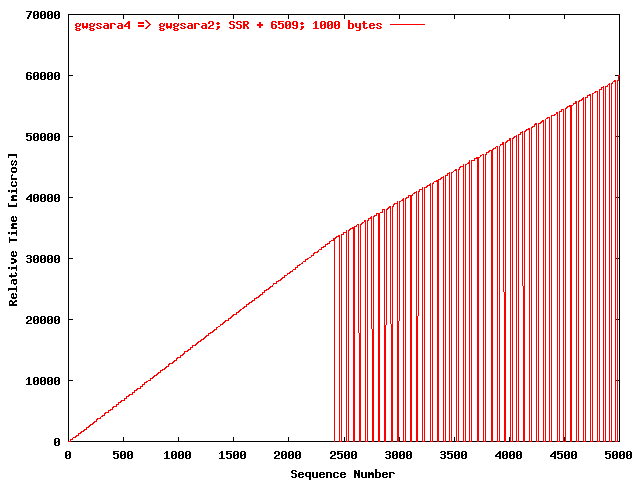
| .II. |
|
The relative receiving time as funtion of the packet
sequence number for the UDP stream gwgsara4 =>
gwgsara2 using the SSR + 6509. The packet size was
1000 bytes. |
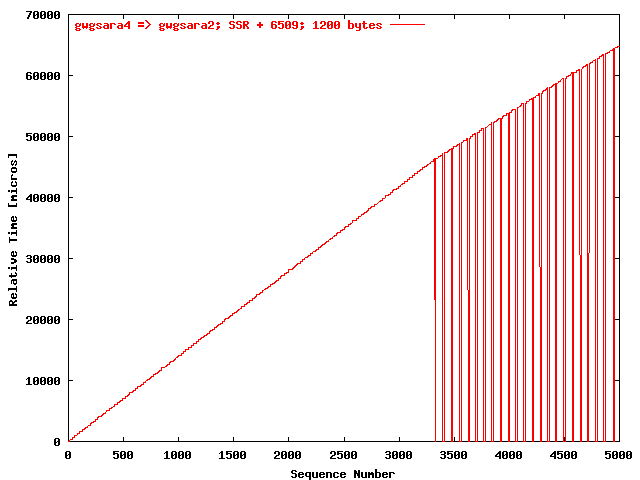
| .III. |
|
The relative receiving time as funtion of the packet
sequence number for the UDP stream gwgsara4 =>
gwgsara2 using the SSR + 6509. The packet size was
1200 bytes. |
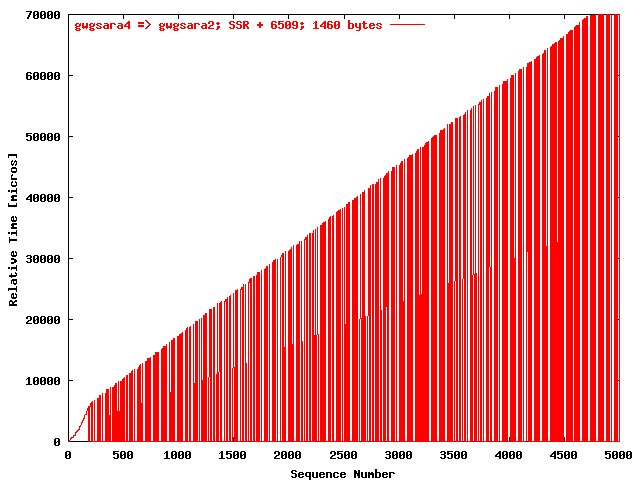
| .IV. |
|
The relative receiving time as funtion of the packet
sequence number for the UDP stream gwgsara4 =>
gwgsara2 using the SSR + 6509. The packet size was
1460 bytes. |
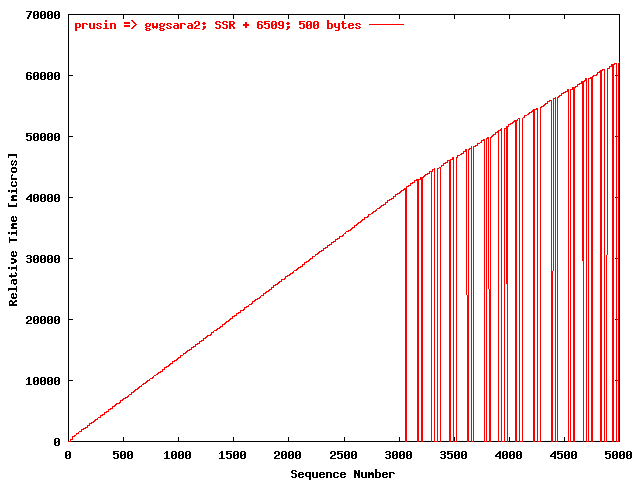
| .I. |
|
The relative receiving time as funtion of the packet
sequence number for the UDP stream prusin =>
gwgsara2 using the SSR + 6509. The packet size was
500 bytes. |
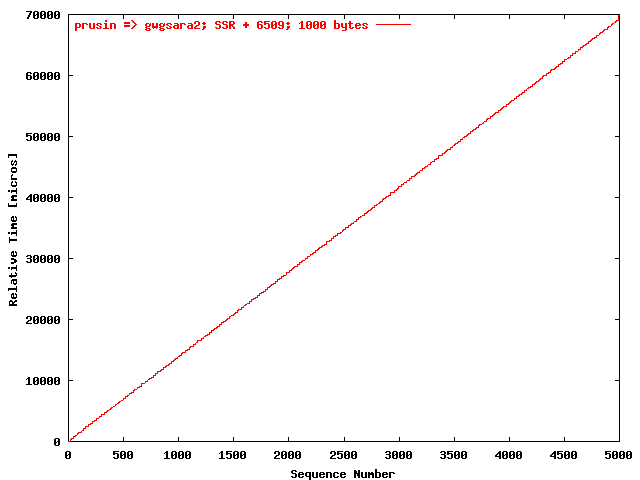
| .II. |
|
The relative receiving time as funtion of the packet
sequence number for the UDP stream prusin =>
gwgsara2 using the SSR + 6509. The packet size was
1000 bytes. |
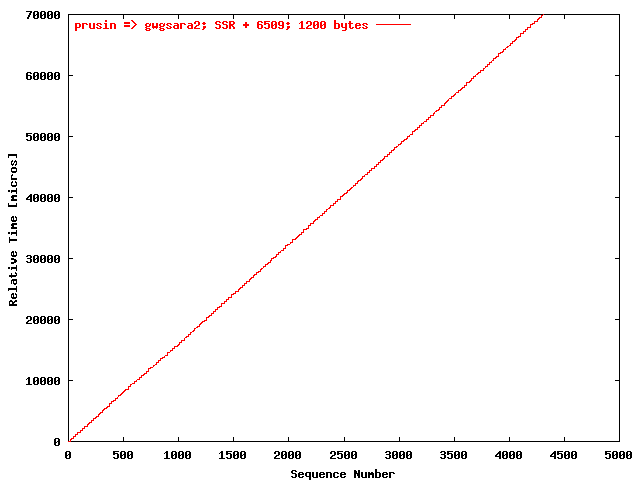
| .III. |
|
The relative receiving time as funtion of the packet
sequence number for the UDP stream prusin =>
gwgsara2 using the SSR + 6509. The packet size was
1200 bytes. |
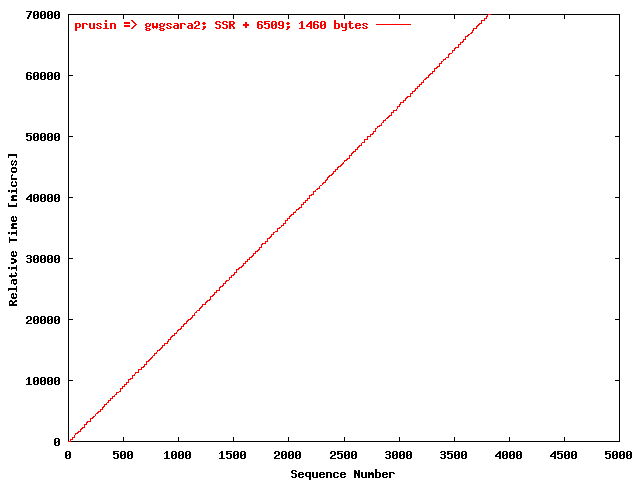
| .IV. |
|
The relative receiving time as funtion of the packet
sequence number for the UDP stream prusin =>
gwgsara2 using the SSR + 6509. The packet size was
1460 bytes. |
Path
(src => dest)
|
Packet size
[bytes]
|
Bandwidth
[Mbit/S]
|
Last recv.
eq. nr
|
# Packets
lost
|
| gwgsara2 => gwgsara4 |
500 |
297 |
776 |
2479 |
| 1000 |
581 |
2049 |
730 |
| 1200 |
690 |
2663 |
444 |
| 1460 |
514 |
322 |
2977 |
| gwgsara2 => prusin |
500 |
321 |
423 |
2464 |
| 1000 |
502 |
615 |
1442 |
| 1200 |
536 |
494 |
1588 |
| 1460 |
590 |
469 |
1398 |
| gwgsara4 => gwgsara2 |
500 |
297 |
828 |
2267 |
| 1000 |
580 |
2410 |
678 |
| 1200 |
689 |
3325 |
310 |
| 1460 |
373 |
183 |
3105 |
| prusin => gwgsara2 |
500 |
295 |
3061 |
409 |
| 1000 |
572 |
4999 |
0 |
| 1260 |
587 |
4999 |
0 |
| 1460 |
638 |
4999 |
0 |
| . |
|
The bandwidth calculated
with ,
the last received packet without lost, and the
# packets lost given as function of the packet
size, using the SSR + 6509. The results of all
paths are presented
here. |
SNMP Counters
By using the appropriate incoming and outgoing octet counters, marked with
"S" in the scheme, packet lost
at the route trajectories, described below, can be detected. There is also
marked which paths are passing these trajectories.
-
In Amsterdam over the SSR
(paths 1, ..., 4).
-
From Amsterdam to Chicago over the Lambda
(paths 1, ..., 4).
-
Over the LSD 6509
(paths 1
and 3).
-
From Chicago to Amsterdam over the Lambda
(paths 1,
3
and 4).
During these tests were only packets lost at the SSR. In
the packages lost have been listed that were found at the SSR for the
corresponding paths and packet sizes. The table header
"SNMP" -> "Packets lost" is the
loosely conversion of the SNMP octets lost to SNMP packets lost by division by
the packet size.
Path
(src => dest)
|
Packet size
[bytes]
|
SNMP
|
UDPmon
|
|
Octets lost
|
Packets lost
|
Packets lost
|
| gwgsara4 => gwgsara2 |
500 |
865187 |
1730 |
2267 |
| 1000 |
708134 |
708 |
678 |
| 1200 |
385270 |
321 |
310 |
| 1460 |
0 |
0 |
3205 |
| prusin => gwgsara2 |
500 |
221531 |
443 |
409 |
| . |
|
Packages lost at the SSR detected for the corresponding
paths and packet sizes. |
Conclusions
The SNMP counters show that some of the packets lost can be related with
incoming traffic at the SSR to host gwgsara2. For those losses there is a good
correspondence with the UDPmon results. However, most losses are again due to
host effects.
^ Other UDPmon Large Results























